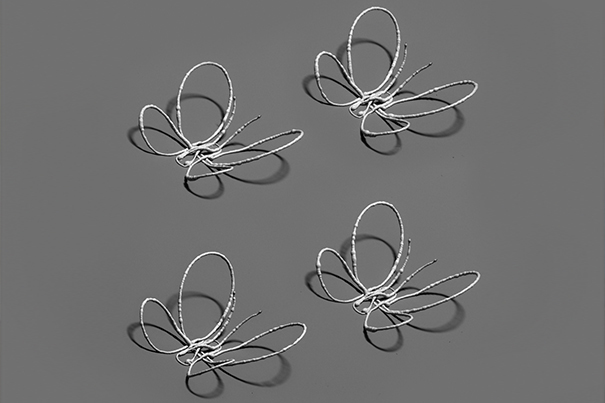By now, the image most people have of the additive manufacturing (AM) process is one where blocky machines quietly hum away and eventually produce a complete object. Some systems allow those with the inclination to watch the process at work, some don’t. The process isn’t particularly dynamic and, excepting toys like the 3Doodler, don’t produce solid objects from thin air.
At least that used to be the case. A few AM projects are moving toward more freeform applications that eschew standard forms of 3D printing in favor of an approach that allows for even more design flexibility. Harvard researchers have added some momentum to that approach with a new process that allows for freeform metal printing without requiring support structures.
 These silver butterflies were 3D printed without requiring support structures. Courtesy of Lewis Lab/Wyss Institute at Harvard University.
These silver butterflies were 3D printed without requiring support structures. Courtesy of Lewis Lab/Wyss Institute at Harvard University.The new process is the result of collaboration between Harvard’s Wyss Institute for Biologically Inspired Engineering and the John A. Paulson School of Engineering and Applied Sciences. The initial trials used an “ink” of silver nanoparticles that is pumped through an extruder head. A laser solidifies the ink in place as it leaves the head, allowing for the creation of three dimensional objects in open space.
Along with the potential to build objects without requiring support structures, the new metal used in the new process is conductive. Combined with the nearly negligible amount of heat used in the process, this allows fine silver wires to be printed directly onto low quality or flexible plastics. According to the research team, the biggest obstacle in developing the process was fine tuning the required distance between laser and nozzle.
“If the laser gets too close to the nozzle during printing, heat is conducted upstream, which clogs the nozzle with solidified ink,” said Mark Skylar-Scott, Wyss Institute Postdoctoral Fellow. “To address this, we devised a heat transfer model to account for temperature distribution along a given silver-wire pattern, allowing us to modulate the printing speed and distance between the nozzle and laser to elegantly control the laser annealing process ‘on the fly.’”
Results of the research have been published at PNAS under the title “Laser-assisted direct ink writing of planar and 3D metal architectures.” Potential applications include customizable electronics and biomedical devices. Below you’ll find a video about the project.
Source: Harvard
About the Author
Follow Robotics 24/7 on Linkedin
Article topics
Email Sign Up
















